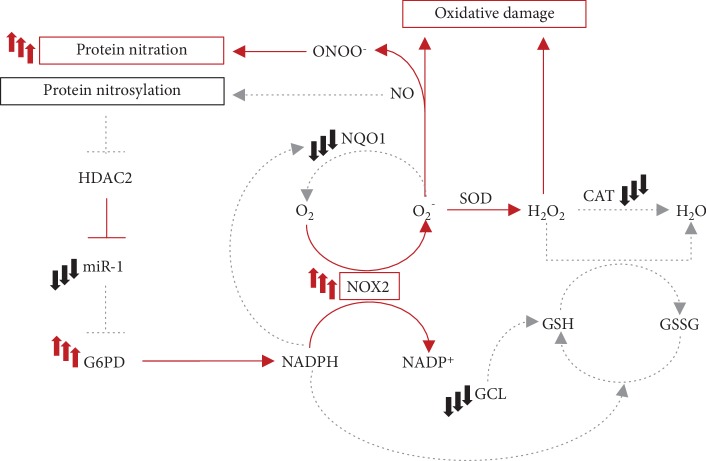Figure 4.
A proposed model of the impact of elevated levels of circulating IL-6 on skeletal muscle redox balance. The reported scheme represents molecular circuits involved in the generation and neutralization of reactive species in skeletal muscle. Red lines indicate mechanisms that are potentially enhanced by elevated levels of circulating IL-6. Grey dot lines represent processes which might be impaired in NSE/IL-6 muscle. In the presence of nonphysiologic amounts of serum IL-6, NOX2 expression is enhanced in diaphragm muscle, inducing a sustained generation of superoxide (O2−). The downmodulation of NQO1 in muscle tissue exposed to increased levels of serum IL-6 indicates that the NOX2-derived superoxide might be not efficiently neutralized. On the other hand, O2− is converted by SOD into hydrogen peroxide (H2O2), whilst its further detoxification can be impaired by the reduced expression of CAT. H2O2 can also be neutralized through the oxidation of glutathione. The reduced expression of the rate-limiting enzyme to produce glutathione (GSH), GCL, might reflect an impaired activity of the glutathione system. The excess of O2− can also interact with nitric oxide (NO) inducing protein modifications. Moreover, the altered regulation of the NO signalling pathway might induce a deregulated expression of glucose 6-phosphate dehydrogenase (G6PD), the enzyme responsible for the production of NADPH, further enhancing the activity of the NOX2 complex in a feed-forward circuit. NOX2: NADPH oxidase 2; NQO1: NAD(P)H quinone dehydrogenase 1; SOD: superoxide dismutase; CAT: catalase; GCL: glutamate-cysteine ligase; ONOO−: peroxynitrite; HDAC2: histone deacetylase 2; GSSG: oxidized glutathione.

